Light Painting History | Light Painting Photography (original) (raw)
Photography comes from the Greek words phos (“light”), and graphis (“stylus”, “paintbrush”) or graphí, together they mean “drawing with light”. Light Painting Photography can be broken down into 3 general categories. The first is Light Drawing this is where the light source can be seen by the camera, during a long exposure the artist uses this light source to draw or create a design within the frame. The second category is Kinetic Light Painting, for this light painting technique the lights in the scene generally remain stationary while the camera itself is moved about during a long exposure to create color and design within the frame. The third category is Light Painting, this is where the artist uses handheld light sources to selectively illuminate parts of a scene during a long exposure photograph. The history below identifies many of the pioneers of Light Painting Photography. If you know of someone who should be included on the list and is not, please send us an email.
Étienne-Jules Marey and Georges Demeny: Light Painting 1889
Étienne-Jules Marey and Georges Demeny first met when Demeny enrolled in a physiology course being taught by Marey. The soon became close associates. Together they established a programme of research which was to lead to the creation of the ‘Station Physiologique’, which opened in 1882 in the Bois de Boulogne. Marey and Demeny developed several photographic techniques to study the movements of everything from humans to horses.
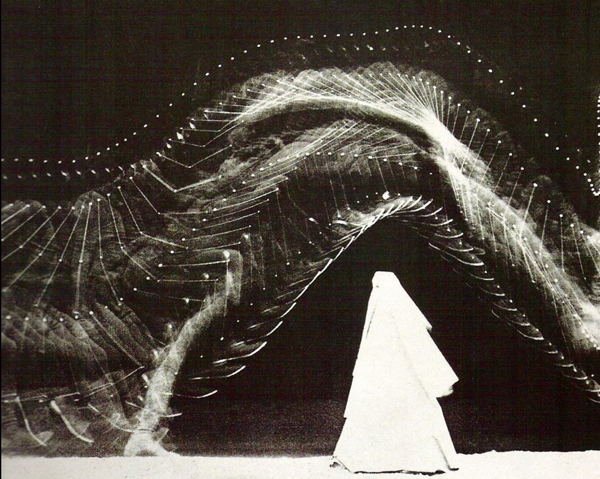
In 1889 Demeny attached incandescent bulbs to the joints of an assistant and created the first known light painting photograph “Pathological Walk From in Front”.

Etienne-Jules Marey was also the first to write using long exposure photography as seen in this image below. We can consider this the first light writing even though Marey did not use a light source to draw the text instead he used a white ball on the end of a black stick against a black background utilizing the reflected light off the white surface of the ball to leave the traces in the image. Possibly also the first use of reflected light and movement used to create a image!

Frank Gilbreth: Light Painting Photography, 1914
In the year 1914 Frank Gilbreth, along with his wife Lillian Moller Gilbreth, used small lights and the open shutter of a camera to track the motion of manufacturing and clerical workers. The Gilbreth’s did not create these light painting photographs as an artistic endeavor; they instead were studying what they called “work simplification”. The Gilbreth’s were working on developing ways to increase employee output and simplify their jobs. You can view the original Gilbreth films HERE.
 Cyclegraph Cyclegraph |
 Work Simplification Study Work Simplification Study |
|---|
Vilho Setälä: Light Painting Photography 1928
Finnish photographic pioneer Vilho Setälä began experimenting with photography at the age of 14 with a 9×12 film camera. In 1927 Vilho acquired a new “cinematic film camera” and began to explore the field of “creative photography” these explorations led to the image you see here known as “Electric Chandelier” from 1928. Electric Chandelier could be the first Kinetic Light Painting, that meaning the light in the scene stays stationary and the camera is moved to create the design during a long exposure. Setälä continued his creative explorations and eventually opened his own photo studio in Helsinki in 1932 where he worked as a professional photographer until 1945. Vilho also helped German camera maker Leica develop lenses after “defining the exact effect of the lens aperture on the sharpness range of the image and engraved the depth of field scale on the Leica camera.”

Man Ray: Light Painting Photography, 1935
The first artist to explore the technique of light painting was Man Ray. Man Ray was best known for his avant-garde photography. He worked in several different media, and thought of himself as a painter above all else. Man Ray’s contribution to light painting photography came in his series “Space Writing”. In 1935 Man Ray set up a camera to produce a self-portrait. He opened the shutter of his camera and used a small penlight to create a series of swirls and lines in the air. Random circles and swirls are all these photographs were thought to be until in 2009, a photographer by the name of Ellen Carey, held a mirror up to the work and discovered the seemingly random light drawing was actually Man Ray’s signature.

Space Writing by Man Ray

Space Writing
Wynn Bullock: Light Abstractions Late 1930’s
In the late 1930’s Photographer Wynn Bullock was working on his series called Light Abstractions. This was a series in which Wynn used reflected, transmitted, and refracted light as the subject matter of his images. Below is the first known image of a light painted spirograph.
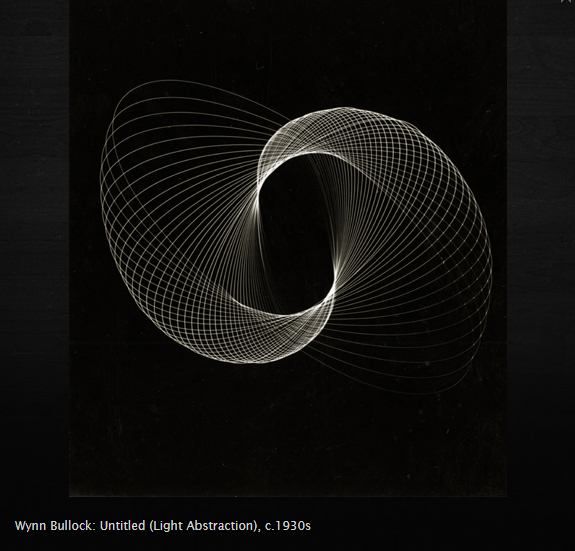
Gjon Mili: Light Painting Photography, 1930-1940’s
Next on the list of light painters is Gjon Mili. Gjon Mili was born in Albania and came to the United States in 1923. Gjon was trained as an engineer and was a self-taught photographer. In the mid 1930’s Mili, working with Harold Eugene Edgerton from Massachusetts Institute of Technology (MIT), pioneered photoflash photography. Gjon used stroboscopic light to capture the motion of everything from dancers to jugglers in a single exposure. His photoflash techniques are still very much used today in light painting photography. Mili used this technique to study the motion of dancers, musicians, and figure skaters.
Mili’s creation of photoflash photography work was just his first gift to the light painting world. In the 1940’s Gjon attached small lights to the boots of ice skaters he then opened the shutter of his camera and created what would be the inspiration for some of the most famous light painting images ever created.
In 1949, while on assignment for Life Magazine, Gjon Mili was sent to photograph Pablo Picasso at his home in the South of France. While there Mili showed Picasso some of his light painting photographs of the figure skaters. Pablo was immediately inspired, Picasso took a penlight and began to draw in the air. Mili set up his camera and captured the images. This brief meeting yielded what would become known as Pablo Picasso’s Light Drawings. Of all of these Drawing the most famous is known as “Picasso Draws a Centaur”.
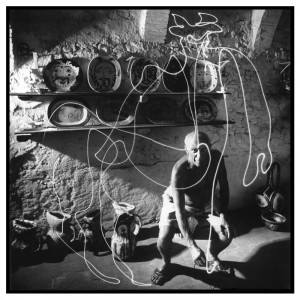 Picasso Draws a Centaur Picasso Draws a Centaur |
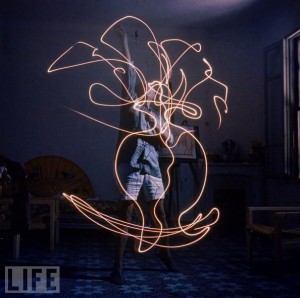 Everything is Illuminated Everything is Illuminated |
|---|
Henri Matisse: Light Painting Photography 1949

This is the only known image of Henri Matisse creating a light painting, Like Picasso, Henri Matisse was also introduced to the light drawing art form by Gjon Mili.
Barbara Morgan: Light Painting Photography, 1940
Barbara Brooks Johnson was born on July 8, 1900, in the USA. She graduated from UCLA in 1923 where she studied figurative drawing and painting. In 1925 Barbara married Willard D. Morgan, a writer that illustrated his own articles with his photographs. Barbara began to assist Willard with his photography shoots, however she continued to paint only seeing photography as a way to document, not an artistic medium. In 1935 with two small children she was searching for a way to be a mother and an artist. While photographing a Sudan fertility icon and an Ivory Coast totemic mask, Barbara discovered that she could make these ritual sculptures seem either menacing or benign, simply by control of lighting. This was her gateway into seeing photography as an artistic medium. She then learned how to process in the darkroom and began photographing dancers. In 1940 in her continuing quest to do more with photography, Morgan “began to feel the pervasive, vibratory character of light energy as a partner of the physical and spiritual energy of the dance, and as the prime mover of the photographic process. “Suddenly, I decided to pay my respects to light, and create a rhythmical light design for the book tailpiece.” She created gestural light drawings with an open shuttered camera in her darkened studio.

Jack Delano: Light Painting Photography, 1943
In 1943 Jack Delano a photographer for the Farm Security Administration used a slow shutter light painting technique to capture to motion of railroad workers and railroad cars while snapping photographs of the Indiana Harbor Belt Railroad.
Andreas Feininger: Light Painting Photography, 1949
In February 1949 another Life Magazine photographer created some light painting photographs. In 1939 photographer, Andreas Feininger, immigrated to the United States. In 1943 he joined the staff of Life Magazine and in 1949 Andreas was on assignment in Anacostia, Maryland, Feininger set his camera up on a tripod, opened the shutter and produced light painting photographs of helicopters taking off and landing.
David Potts: Kinetic Light Painting
Kinetic Light Painting also known as Camera Painting is the process of moving the camera itself to create a design within the frame during a long exposure photograph, the lights in the scene generally stay stationary (although they don’t have to). David Potts was widely recognized for his black and white documentary style photography when he began creating his colorful works. David said “Very simple. I wanted to explore what the available colour films would do.” These works slightly predate the elegant colourist compositions of legendary fellow LIFE photographers such as Ernst Haas. In his 1953 image Potts transforms the familiar London landmark into a swirling mandala of colour. “I had a Linhof 5×4 view camera I had bought from Max Dupain with a [film] back that rotated 360 degrees. I simply wanted to see what using the camera’s movements – turning the film around – would do [to Piccadilly Circus] during a long exposure.” (source)

George Mathieu: 1957
George Mathieu is a French painter who gained an International reputation in the 1950’s as a Abstract Expressionist. In 1957 George was in Tokyo Japan and used light painting to create this cover shot for a Japanese magazine.
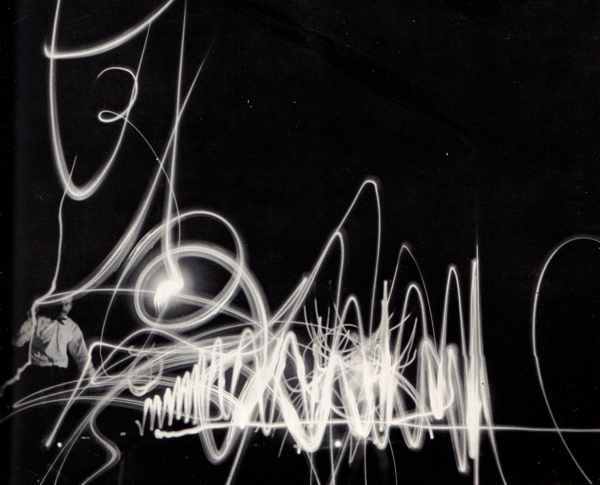
David Lebe: Light Drawings, 1976
In 1969 photographer David Lebe began experimenting with pinhole cameras. It was this experimentation that lead to his revelation that a photograph didn’t have to just capture an instant in time but that it could capture a whole event. In 1976 David was looking for an escape from his small cluttered Philadelphia apartment, so he turned out the lights. In the dark David was able to image the larger spaces he wished for. He opened the shutter of his camera and began work on the first of his light drawing series. These first images were self portraits where David used small pin lights to outline his own body.
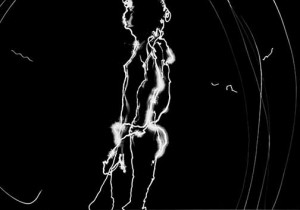 |
 |
|---|
Eric Staller: Light Painting Photography, 1976
Eric Staller could be called the father of light graffiti or light drawing in its present day form. Staller was born in 1947 in New York. He studied architecture at the University of Michigan and graduated with a bachelor’s degree in 1971. Towards the end of his time at UOM Eric started to create sculpture and pieces of performance art. From 1976 to 1980 Staller roamed the dark streets of New York City creating light painting photographs.

Ribbon on Hannover Street
Eric’s “Light Drawings” series could be the very first Light Art Performance Photographs ever created. It could be argued that Man Ray’s “Space Writing” series were the first light art performance pieces but there is no doubt that Staller’s images such as Light Tubes, Happy Street, and Technicolor Torsos all evoke elements of performance art. Eric’s “Light Drawings” series is one of the most influential series on light painters today.
 |
 |
|---|

Technicolor Torsos
Dean Chamberlain: Light Painting Photography, 1977
Dean Chamberlain is the father of light painting photography in its present day form. He is the first artist to dedicate his entire body of work to the light painting art form. Dean was taking classes at Rochester Institute of Technology when he made his discover of light painting in the spring of 1977 when he created his first ever light painting “Polyethylene Bags on Chaise Lounge”
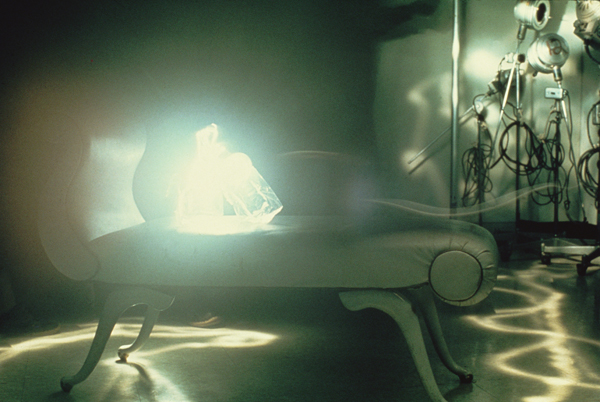
Dean was in his third year of college, he was experimenting and struggling to find his calling. Dean says he felt like his classmates were “blowing him out of the water” with their work. That was until Dean developed one special role of film. The instant that Dean saw his first light painting image he knew he had found what he was looking for. From that moment on Dean has only made light painting images. He may be the first person that actually called what he was doing “Light Painting”.

Susan Hillbrand: Light Painting Photography, 1977
Susan Hillbrand began light painting in 1977. She was in a photo class at California State University, Northridge (where she graduated with a BFA in 2-D Art) when her instructor Jerry McMillian assigned the task of creating an unusual self portrait. Susan was throwing around some ideas when her husband suggested “you should try outlining your body with light” that statement sparked the idea of Susan’s first “Penlight” and what would become a lifelong passion.
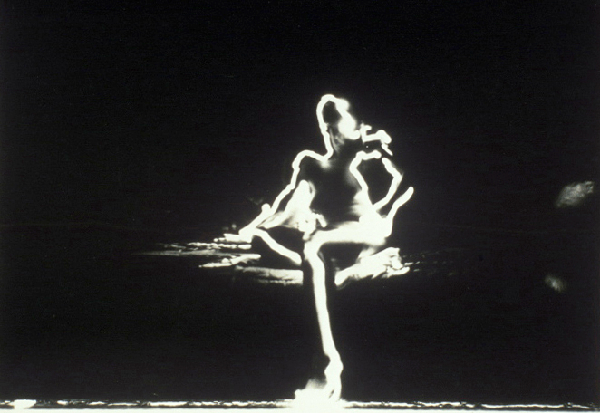
Jacques Pugin: Light Painting Photography, 1979
Landscape photographer Jacques Pugin was born in Bulle, Switzerland and moved to Zurich to become a photographer in 1972. In 1979 he began work on his light painting series “Graffiti greffés”. Jacques continued working on his light paintings until 1982. “Graffiti greffés” was broadly exhibited and published on an international level. Pugin’s light painting work was so well received he was awarded the Federal Grant of Applied Arts for three consecutive years.
Jozef Sedlák: Light Painting Photography, 1980
Photographer Jozef Sedlák was born in 1958 in Bratislava, Slovakia. Sedlák began his light painting work in 1980 with his series “Kurz sebapoznania”. Kurz sebapoznania translated into english means “Rate-Self Knowledge”. He is one of a group of artist working with staged photography who, in the 1980’s, represented Slovakia on the international scene.

Rate Self-Knowledge 1982
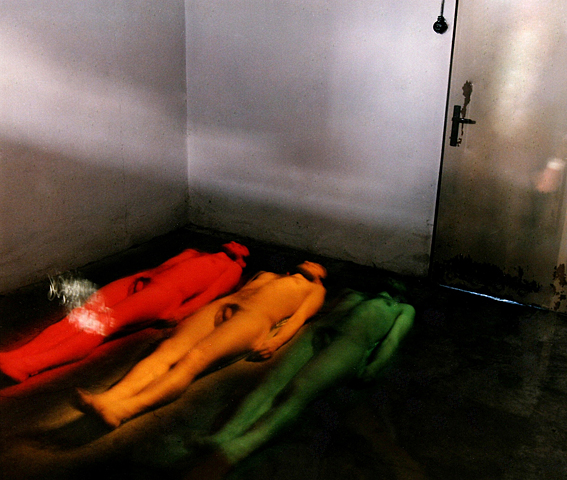
Rate Self-Knowledge 1983
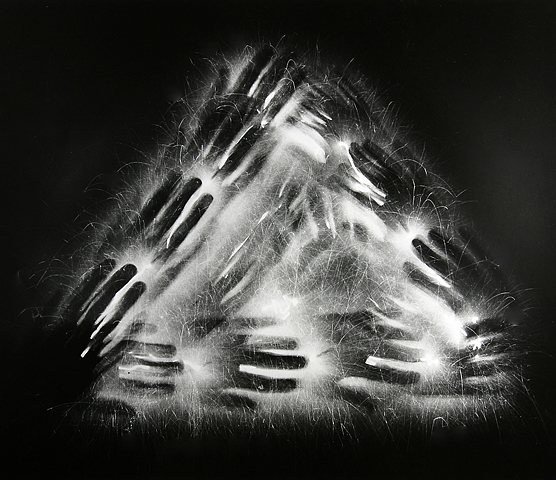
The Light of Democracy #2 1990

Stories from the Subconscious 1992
Vicki DaSilva: Light Painting Photography, 1980
Vicki DaSilva started creating her Light Painting Photographs in 1980 while she was attending college. Her work was heavily influenced by Joan Jonas and Richard Serra; artists that she worked with in her early years. Vicki has the honor of holding several light painting titles. She is the first female light painting artist and the first light painter to create “Text Light Graffiti”. In 1986 Vicki was on a light painting trip to Paris where she met her husband Antonio DaSilva. Antonio was an electrician and she was searching for a way to use fluorescent bulbs in her work, they began light painting together in 1988. This was also the year (1988) when Vicki began attaching the fluorescent lights to a pulley track system. She is known for her light graffiti work as well as her elaborate installation based light paintings. Vicki also creates handheld traces and designs that she calls “Light Graffiti”. Vicki lives in Pennsylvania and continues to create light painting photographs.
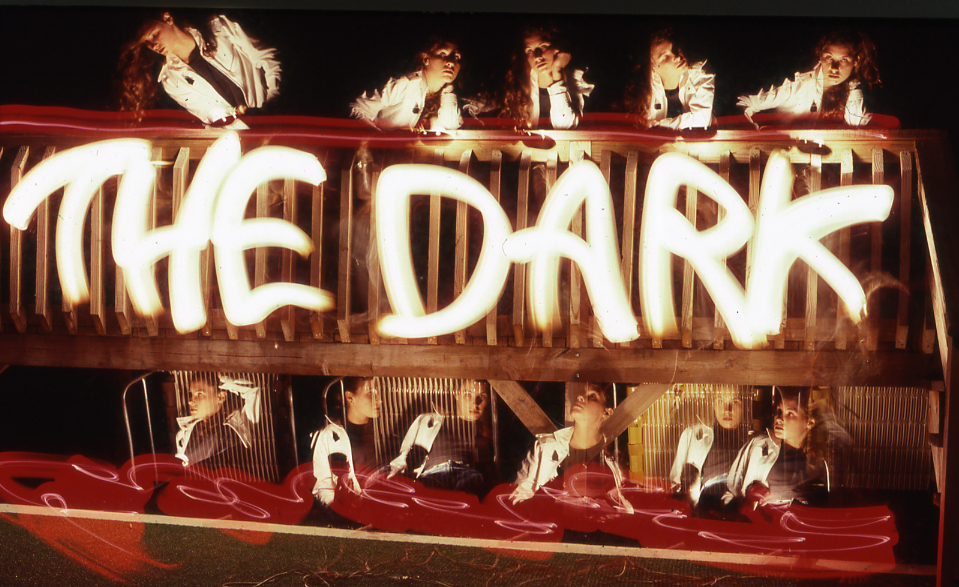 |
 |
|---|
 |
 |
|---|
Mike Mandel: Light Painting Photography, 1980
Directly inspired by the Chronocyclegraphs of the Gilbreth’s and molded by his fathers efforts to “Make Good Time” Mike Mandel set out on a 10 year journey starting in 1980 creating efficiency studies or everyday life. Mike’s images “were made as a satire, examining daily life tasks that didn’t need to be analyzed for efficiency’s sake”. Click here to read the LPP interview with Mike Mandel.
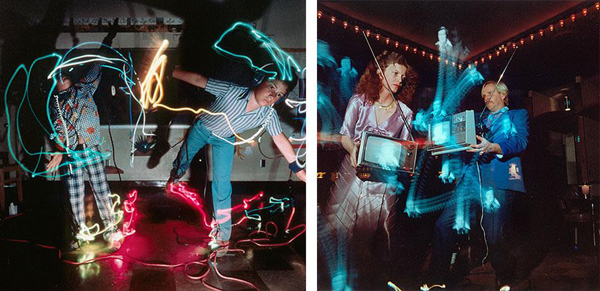

Kamil Varga: Light Painting Photography, 1983
Kamil Varga calls his light painting photography “ Luminographie” and he describes it as “drawing with light on photosensitive material”. He began light painting or “Luminographie” in 1983 when he created one of his first image “Paths of Light”.

Kamil has created a large amount of work spanning several decades. His Light Painting images are focused on the human form. Kamil says this of his choice of mediums “Luminografie is great that you do not need a studio, you can practice quietly at home. Just a room where there is complete darkness.”
John Hesketh: Light Painting Photography, 1985
In 1985 Artist John Hesketh took his camera into his back yard and began work on his first light painting series “Homelife”. The subject matter of this series were objects in his everyday home life. John says this about the series “Before I was working with this work I was interested in how black and white records of red, green and blue made a full color image. While an image was separated I would draw paint scratch each black and white record before reassembling them on color film using the RGB filters. Making colors using a black crayon or paint was intense, educational, but very time consuming, 3 to 6 months an image. I also felt graphic instead of photographic. One night I took the camera and filters that I had been using to reassemble my drawings onto film, outside into my backyard and pointed it at this statue and cactus. The next day I saw this film and the road ahead.” John uses color filters in his work where he will separate one color from entering into the camera while he is light painting. Hesketh lives in Anaheim California and continues to explore his light painting process with his latest light painting series “Los Angeles”
Tokihiro Sato: Light Painting Photography, 1988
Tokihiro Sato was born in 1957 in Sakata, Yamagata Japan. His Light Painting series Photo-Respiration is his most well known work. Photo-Respiration consists of two subsets, Breathing Light and Breathing Shadows. Sato shoots with an 8×10 camera and his exposures can last up to three hours. He was trained as a sculpture but found that photography better suited his desires.
received his Masters degree from Tokyo National University. His light painting photographs are held throughout the world in public and private museums including the Guggenheim in New York and Museum of Modern Art in Saitama, Japan. He is currently a professor at the Tokyo University of the Arts and continues to work on his light painting imagery.
This is an evolving timeline of the history of light painting photography. If you know of any other artist that should be included in this light painting timeline please contact us. For a list of the artist currently pushing the limits of light painting photography please review the featured artist section of the site here.